Totally Unnamed Gaming Column - Rhythm is a Dancer
by Ryan Blackmore,
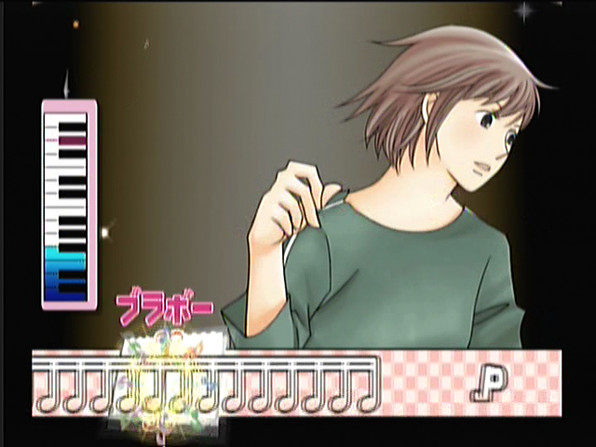
|
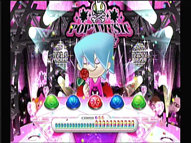
|
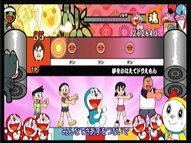
|
|
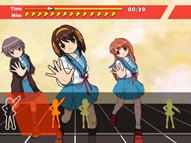
|
|
 | |
Welcome to our currently unnamed gaming column. This week's mostly the work of DW who will be looking at some Japanese Rhythm games available on the Japanese Wii. Mutsuki will be back next week to have a look at a wide selection of the other stuff available on our friendly Nintendo consoles. After the reviews you'll find details of the competition we're currently running that let's YOU, the reader, get a chance to name this column in exchange for fabulous prizes.
As a Video Game Enthusiast and budding Musician, one genre I enjoy thoroughly is Rhythm games. I've played a wide spectrum of them ranging from Gitaroo Man to Britney's Dance Beat. These days rhythm games have hit the mainstream with Rock Band and Guitar Hero as the front of the pack. What most people don't know is that these games were inspired by the Bemani games GuitarFreaks, DrumMania, Beatmania and Keyboard Mania. They had the concept of flailing on plastic instruments and playing along to cover versions of songs long before Guitar Hero even came out.
With most Japanese rhythm games you don't really need that much knowledge of Japanese to play them. The typical rhythm game opens into a selection of songs with audio previews and if you watch a decent amount of anime you'll find a number of familiar songs as anime opening themes make up a sizable chunk of Japanese rhythm game song offerings. Outside of arcades it's rare to find these games being released here.
Usually when a Japanese rhythm game is brought over to a western market it usually has its entire music catalog replaced with American pop hits and the game re-branded to suit the local market. Ouendan, the Japanese rhythm/cheering game which was remade into Elite Beat Agents is a classical case in point.
With the success of the Rock Band and Guitar Hero games I can see rhythm games becoming even more popular in the future, especially with the release of Rock Band: The Beatles which will bring in a whole bunch of people who didn't know about the Rock Band games or wouldn't usually play them. It's a good thing, and maybe the growth will encourage Japanese companies to bring games over too.
Wii: The Excitement of Suzumiya Haruhi (Kadokawa Shoten)
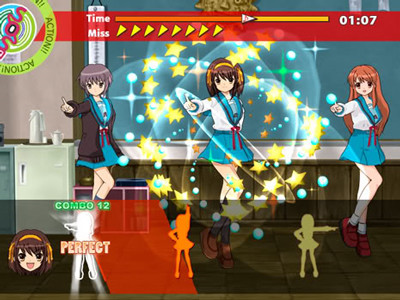
|
|
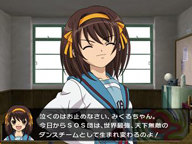
|
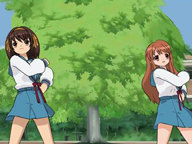
|
| Probable Rating | PG (Mild Sci-Fi Themes) |
| Release Date | 22/01/2009 |
| # of Players | 1-3 |
| Availability | Import: Common |
| Language | Japanese |
| Fluency/Literacy Level | Beginner: Hiragana/Katakana |
One in the growing number of Haruhi games, 'The Excitement of Suzumiya Haruhi' also proves that using motion controls is the worst idea possible when it comes to making a rhythm game. When it comes to playing the actual game the in-game instructions and the manual don't help, as they're not actually explained even in Japanese clearly. After flailing my way to failure I resigned myself to searching the internet for some form of help which came in the form of a YouTube Video.
The theory is that you hold the WiiMote vertically and then move it in time to one of the 8 directions that come on screen. In practice I was struggling to hit half the notes and I'm fairly good when it comes to rhythm games. Individual moves are quite easy to do and they register most of the time, but when you have quick chains of 3+ moves you find yourself flailing around to no avail. The gameplay could have been a lot better if they had just used the directional pad and maybe some buttons. The developer had other ideas and wanted to show how modern they were by implementing Wii motion controls. Unfortunately, it didn't work.
After every other song or so you're treated to one of two minigames: Homerun and JanKenPon (Rock, Scissors, Paper). The JanKenPon game is fairly simple, you choose either A (Rock), B (Scissors) or A+B (Paper). If you both pick the same move you go again but if you win or lose you go to the second part of JanKen which is really only played in Japan where the winner points to a direction and if the loser looks in that direction they get a point, but if they look elsewhere no one gets any points and it goes back to stage 1. It's quite enjoyable but it can possibly take you a really long time to complete (win OR lose).
The other game, Homerun, is baseball batting game that's very poorly designed. Instead of using the motion controls in a decent way like Wii Sports Baseball, you have to choose one of five areas to swing at through a combination of buttons and movements. The instructions for which only appear once in the game and if you didn't pay attention you're screwed.
The story mode is your typical visual novel cutscenes interspersed with dancing, following the story of the SOS Brigade trying become famous and succeeding by uploading a video of one of their dance routines onto the Internet and getting a bazillion views and comments. There is also a far shot of the school with all the students dancing and then suddenly everyone except Haruhi is teleported to a desert and has to have dance-off with 2 Shadow Haruhi's. At this point the game suddenly ends and all you're left with is a “to be continued…” All this takes place within 2 hours and that's if you sit through all the cutscenes.
The in-dance graphics are very reminiscent of the IdolMaster games, but slightly shoddier since they're limited by the Wii's graphical power. It's pretty much marketed to the same audience as well since there's a lot of customization options that you unlock through story mode that you can then use in Free Mode. The music available consists of a number of songs from the Anime as well as a few additions and remixes, but when it comes to Hare Hare Yukai you pretty much have to complete the game with a near perfect score. Which is strange since I would've thought you would have had that song from the start as it's THE Haruhi dance song.
Overall the game feels like it's a rushed and/or low budget game. However as it's a Haruhi game it sold truckloads in Japan. When they release the sequel I hope they address the control issues and at least include more content, because it's not all that bad, just far too many flaws as it stands.
Wii: Taiko no Tatsujin Wii (Namco Bandai Games)
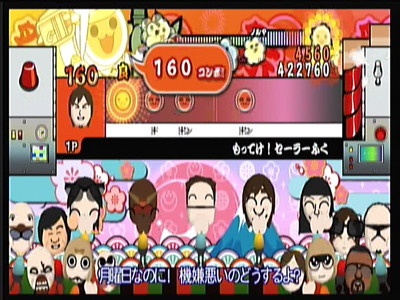
|
|
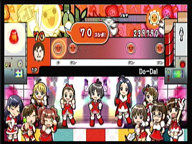
|
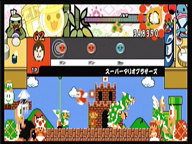
|
| Probable Rating | G |
| Release Date | 11/12/2008 |
| # of Players | 1-2 |
| Availability | Import: Common |
| Language | Japanese |
| Fluency/Literacy Level | Beginner: Hiragana/Katakana |
The latest iteration of the popular Taiko no Tatsujin games, Taiko no Tatsujin Wii goes against the grain of most rhythm games on the Wii by not implementing motion controls in any form. The game instead comes with the Taiko Drum controller you can plug into your Wiimote for wireless drumming goodness and if you want to have two people playing, additional drum controllers can be picked up seperately. The drum controller is fairly sturdy, but maybe that's because you have to hit it fairly hard for it to register.
There's two kinds of notes, red and blue, with red being face hits and blue being side hits. I had trouble getting the side hits right, especially in some of the harder/faster songs. The drum controller has 2 holders for your Bachi (Taiko Drumsticks) as well as a tray where you can put your Wiimote, snacks and any other items you'd like to bring with you...
As I went through the game I eventually ditched the drum controller and instead used the WiiMote itself to play the game, since I had trouble keeping up with the notes in the faster songs. The WiiMote control scheme sort of mirrors the drum with the Down, Left (Which is down when holding the WiiMote sideways) and 1 buttons being the face hit buttons as they're towards the middle of the controller and the Up, Right and 2 buttons as the side buttons because they're the outside. This control scheme means you don't need a second drum controller to have 2 players as well as being much quieter than the drum controller.
The game contains over 70 songs, featuring a decent mix of J-Pop, Anime, Video Game, Classical and Children's Songs. Most of the songs feature a randomly chosen set of dancers that's either one of sets of Taiko no Tatsujin characters or a selection of the Miis on your Wii and if you collect all sorts of weird one's from the Mii Contest Channel like I do you might find yourself distracted by the Predator dancing in line next to Nemesis and Snoopy.
At the beginning of each song you start with one dancer and as you fill the progress bar the number of dancers increases to five. When you reach the pass mark the background changes and when you fill the progress bar the audience jumps in and dances along. There are exceptions to the randomly chosen dancer as a few songs feature their own series' characters, like the Idolm@ster, Doraemon and Mario songs. Besides the Idolm@ster songs, Taiko no Tatsujin also features a couple of songs from other Namco/Namco Bandai games such as Ridge Racer and Soul Calibur.
Taiko no Tatsujin caters to all levels of players, the easy songs are easy enough for people who don't have rhythm and the Oni level songs are extremely hard and would probably please most speed metal fans. There's also a challenge mode to get you started off and help you train up your skills.
It's also great fun to play, especially with the drum controller. I thoroughly recommend putting on your Happi Coat and giving it a try. Some knowledge of Japanese is required to play, being able to read hiragana and katakana helps a lot, but it's fairly easy to navigate through the menus without it. As well, all the songs have previews so you're not playing song roulette if you can't read Japanese.
Wii: Nodame Cantabile: Dream Orchestra (Namco Bandai Games)
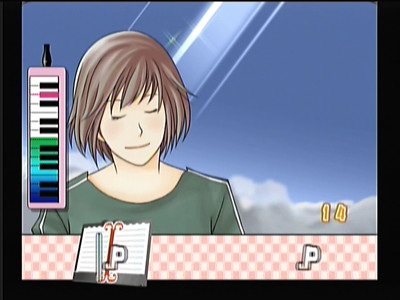
|
|
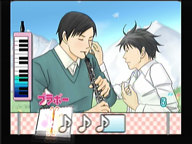
|
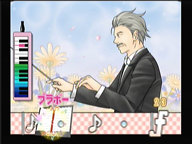
|
| Probable Rating | PG (Mild Adult Themes) |
| Release Date | 27/12/2007 |
| # of Players | 1-4 |
| Availability | Import: Common |
| Language | Japanese |
| Fluency/Literacy Level | Beginner: Hiragana/Katakana |
Nodame Cantabile is a Manga/Anime/Live-Action series that I really enjoy so I had to get my hands on this game once I heard about it and even though the game is nearly two years old at this point in time, I still think that it's a great example of a rhythm game that uses motion control really well.
In the story mode you pretty much follow along with the series, helping out various characters by conducting or playing for them. The cutscenes are done in an animated Manga style with full voice acting by the Anime voice actors which was quite entertaining. The story starts from the beginning of the series and ends just after the start of the Paris-arc, which is where the Manga was up to when the game came out.
The gameplay varies, depending if you're conducting and/or what instrument you're playing. Wind instruments like the flute and oboe are played by holding the controller like the instrument and pressing the buttons while conducting and playing the timpani or violin use motion control exclusively. While the piano uses a combination of buttons and motion control.
Though you won't be confused by all the different control schemes as before each song you're given the option to bring up a guide to playing whatever instrument you're about to play with detailed button schemes and informative picture instructing you on how to play. On occasion the motion control fails to register but it's very rare and not that intrusive.
Multiplayer supports up to four players, but not all songs have four instruments available as well as the songs, just like in real life, being only playable by certain instruments. Being a Nodame Cantabile game it also features a number of mini-games featuring Puri-Gorota and the Fart Song which are quite enjoyable.
I recommend the game to all the fans of the Nodame Cantabile anime who enjoy classical music. It also doesn't require that much knowledge of Japanese (Katakana at best) to play as the story progresses linearly and there's no dialog options needed to be chosen as well as in the menu when you hover over the modes they're mostly spoken in English.
Wii: Pop'n Music (Bemani)
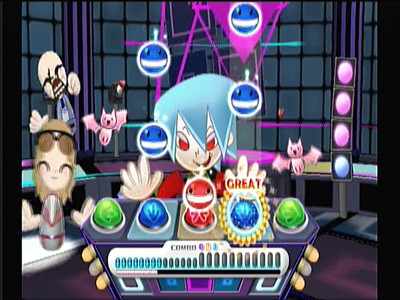
|
|
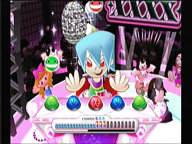
|
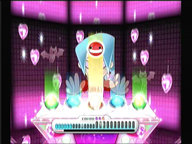
|
| Probable Rating | G |
| Release Date | 06/08/2009 |
| # of Players | 1-4 |
| Availability | Import: Common |
| Language | Japanese |
| Fluency/Literacy Level | Beginner: Hiragana/Katakana |
Pop'n Music for the Wii is based on the Bemani arcade game of the same name. Unlike other Bemani games, like Beatmania and Guitar freaks, Pop'n Music is more catered to younger players and features a more simplified gameplay than the other Bemani games, but it does has harder difficulties that cater for those seeking a challenge.
The gameplay is similar to the arcade game but differs slightly. In the arcade game you have 9 buttons which you hit according to the corresponding notes on the screen, but in the Wii version you use your WiiMote and NunChuk to make your character hit 5 buttons as the notes hit them. The Nunchuk is used to hit the Left and Left Down buttons and the Wiimote is used for the Right Down and Right Buttons while both can be used to hit the center buttons by either moving the Nunchuk to the Right or the WiiMote to the Left.
Once again the limitations of the Wiimote intrude into the gameplay and I found that at first a lot of my Down notes weren't registering at all. I sort of overcame this by using a sort of Wax-On Wax-Off motion to get the down notes, though some down notes still didn't register and on some of the harder songs you're better off just flailing the controls around so you hit all the notes at once.
The music selection is your typical Bemani collection. A mix of J-Pop covers and Classical songs, with the occasional licensed song like Polyrhythm by Perfume, and Bemani staples like Shangai Honey by Orange Range and Rewrite by Asian Kung Fu Generation. It's also got both classic and modern Anime theme songs, from Dragonball and Macross Frontier. Though one holdover from the arcade game is that all the songs are shorter versions of the originals, usually a verse and chorus or chorus, verse and chorus. This is a bit frustrating when you find yourself getting into the groove of a song only to have it finish abruptly.
Overall Pop'N Music is a pretty good rhythm game with a decent music selection, but it's let down by the control scheme and shortened songs.
How about you help us name this column?
Remember, you're as much a part of our ongoing tour as we are, so why not help us name this column? If your name is chosen, you'll get the name titled up top in all its glory... and a little gift from us to get you started on your way.
If you impress us with the name of choice, we'll help you on your way with any two games named in our first column, or any one game named in this column, or any column up to the 31st of October.
The system the games are on aren't included, but you'd be surprised how much effort getting the game alone is...
We'll also give a small bonus for a lucky person who comes up with something interesting to support their, or another entry. The bonus is a secret though - a little lucky door prize for those who go that extra step further.
Enter now by e-mailing our poor editor in chief at [email protected] (jon at animenewsnetwork.com.au?subject=Name%20the%20Column%20Competition) with a suggestion for a name and if you want to try your luck for the bonus, add a little something extra as well.
Don't worry, you don't need to tell us now what you'd like, unless you have your heart set on something named already. The offer's only open to Australian Residents and will close at 11:59 AEST on the 31st of October.
this article has been modified since it was originally posted; see change history